Templo Mayor › Chichen Itza » Ancient origins
Articles and Definitions › Contents
- Templo Mayor › Ancient History
- Chichen Itza › Antique Origins
Ancient civilizations › Historical and archaeological sites
Templo Mayor › Ancient History
Definition and Origins

The Templo Mayor or Great Temple (called Hueteocalli by the Aztecs) dominated the central sacred precinct of the Azteccapital Tenochtitlan. Topped by twin temples dedicated to the war god Huitzilopochtli and the rain god Tlaloc it was a focal point of the Aztec religion and very centre of the Aztec world. It was also the scene of state occasions such as coronations and the place of countless human sacrifices where the blood of the victims was thought to feed and appease the two great gods to whom it was dedicated.
CONSTRUCTION
The Templo Mayor was first constructed in the reign of Itzcoatl (r. 1427-1440 CE), improved upon by his successor Motecuhzoma I (r. 1440-1469 CE), and again enlarged during the reign of Ahuitzotl (r. 1486-1502 CE). These rulers, and others, each employed the resources and labour given in tribute by neighbouring states in order to build a more impressive monument than their predecessors.
The location was chosen with purpose as the temple was a stone improvement on the original shrine the first settlers of Tenochtitlan had built in honour of Huitzilopochtli in the Aztec founding legends. As the temple grew over the years, offerings and precious goods were ritually buried within its ever-expanding layers. The pyramid was reached via a sacred Processional Way constructed along an east-west axis. The Pyramid was similarly built on an east-west axis so that when at the top of the stairway one would face the east and see both Mt. Tlaloc and, on the equinox, see the sunrise exactly between the two shrines on the upper platform. Located at the centre of Tenochtitlan the Templo Mayor was the religious and social heart of the Aztec empire.
THE TEMPLO MAYOR WAS A 60 METRE HIGH ARCHITECTURAL MOUNTAIN DEDICATED TO THE GODS TLALOC & HUITZILOPOCHTLI.
DIMENSIONS & FORM
The Templo Mayor was the most important structure at the centre of a large sacred precinct measuring 365 m (1,200 ft) on each side and surrounded by a wall which, because of its snake relief carvings, was known as the coatepantli or 'Serpent Wall'. The precinct may have contained as many as 78 different structures but the Templo Mayor was by far the tallest and must have dominated the city skyline. The temple was actually a 60 m (180 ft) high pyramid platform with four tiers and two flights of steps on the western side leading to a summit with two twin temples or shrines, the whole structure being faced with lime plaster and brightly painted. The north (right) side shrine was dedicated to Tlaloc, the god of rain and the other, on the south (left) side, was dedicated to Huitzilopochtli, the god of war. Tlaloc was also associated with mountains and it is probable that the Templo Mayor was conceived as a literal architectural mountain in homage to this facet of the rain god, a man-made imitation of Tonacatepetl, Tlaloc's 'Mountain of Sustenance'. At the very same time, and with the typical Mesoamerican passion for duality, it was also a representation of Coatepetl, the sacred 'Serpent Mountain' where Huitzilopochtli vanquished the other gods.

Sacred Precinct, Tenochtitlan
The temple on the north side, painted with blue stripes, was dedicated to Tlaloc and marked the summer solstice (symbolic of the wet season) whilst Huitzilopochtli's south-side shrine, painted red, marked the winter solstice (symbolic of the dry season and a time for warfare ). Within each shrine was a wooden statue of the god. The monumental steps leading to Tlaloc's temple were painted blue and white, the former colour representing water, the element so strongly associated with the god. In contrast, the steps leading to Huitzilopochtli's temple were painted bright red to symbolise blood and war. Both flights carried sculptures of snake heads; those on Tlaloc's side had blinkers while those on Huitzilopochtli's were adorned with feathers.
HUMAN SACRIFICES
Tlaloc was seen as both a giver of essential rain in a frequently harsh environment but also as a destructive force when he sent storms, floods, and droughts. Double reason, then, for the Aztecs to do all they could to keep this fickle deity in a good mood. Huitzilopochtli was the supreme Aztec god and considered the god of the sun, war, gold, rulers, and he was patron of Tenochtitlan.
For the Aztecs the best way to gain favour with these two powerful gods was to honour them with a suitably impressive temple monument and to regularly offer sacrifices to satiate their lusty appetites and perpetuate the harmony between gods and humanity. Further, sacrifices were considered as due payment for the sacrifices the gods had themselves made when they created the world. These offerings could take the form of food, flowers, and precious goods (shells and coral, for example, have been excavated from Tlaloc's shrine) but also, at key times in the calendar especially, blood. The sacrifice of animals and non-fatal blood-letting amongst the priestly class were common practices but the Aztecs have now become infamous for their most dramatic and important choice of offering: human sacrifice.
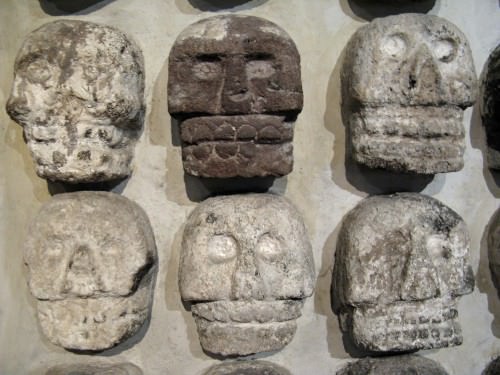
Aztec Skulls, Templo Mayor
A typical sacrifice involved the victim being stretched over a stone while a priest, armed with an obsidian knife, ripped out their heart and then decapitated and dismembered them. Following all that the corpse was flung down the steps of the pyramid to land at the base where a massive round stone depicted Coyolxauhqui, the goddess who was similarly treated by Huitzilopochtli in Aztec mythology after she had led a rebellion against the great god. Finally, the heads of victims were displayed on racks known as tzompantli which were set at the base of the pyramid.
Sacrificial victims were usually war captives but children were also sacrificed as their tears were considered a favourable link with the life-giving raindrops from Tlaloc. The priests who carried out this carnage, on occasion, ate the flesh of the victims, with the heart being the most prized, if it had not already been burned in offering to the gods. The Aztec ruler, privileged nobles, and those who had captured the victims in war also participated in this symbolic feast.
MAJOR CEREMONIES AT THE TEMPLO MAYOR
Sacrifices could also take place to commemorate important state events. One of the most infamous is the four-day butchering of captives when Ahuitzotl re-dedicated the temple and extended it even higher in order to celebrate his imperial triumphs in 1487 CE. Another important event was the New Fire Ceremony, held every 52 years - a complete solar cycle in the Aztec calendar - when the first flaming torch came from Mt. Huixachtlan and was used to light the sacred fire atop the Templo Mayor before being transferred to all subsidiary temples in the city.
The Templo Mayor was also a regular focal point during the celebrations of Huitzilopochtli's birthday in the ceremony of Panquetzalitzli in the month of the same name. Another important festival was held during the month of Toxcatl when an effigy of the god made from dough and dressed in his costume was paraded through the city and then eaten at the Templo Mayor.State funerals occurred at the site, notably the funeral cremation of three rulers: Axayacatl, Tizoc, and Ahuitzotl. Finally, coronations took place at the temple, notably that of the last true Aztec king Motecuhzoma Xocoyotzin, better known as Montezuma, in 1502 CE.

Greenstone Mask, Teotihuacan
LATER HISTORY & EXCAVATION
The pyramid was razed following the Spanish Conquest - the Aztecs had used it as a rallying point and defended it vigorously - and a Christian cross had been placed on top of it. Then over the centuries it was gradually built over and disappeared beneath 19th century CE colonial buildings in downtown Mexico City. Never forgotten, the site was half-heartedly excavated in the early 20th century CE and then systematically from the late 1970s CE. It was then discovered that the pyramid was in fact a succession of pyramids each built over a smaller predecessor and even the original primitive platform, dated with the aid of a stone hieroglyph to 1390 CE, was discovered.
So too, many artefacts, purposely buried by the Aztecs, have been excavated at the site, and these include fine pottery, figurines, jade and mother-of-pearl jewellery, animal skeletons which include fish, a crocodile, two golden eagles and a jaguar, and prizes from earlier Mesoamerican civilizations such as one Olmec mask and another from Teotihuacan. Three of the larger finds related to the temple are the 3.5 metre (diameter) stone of Coyolxauhqui from the pyramid base, a chacmoolsculpture (used to burn victim's hearts) from the shrine of Tlaloc, and a 12-ton rectangular monolith depicting the earth-goddess Tlaltecuhtli. The site continues to be excavated to the present day with regular new findings adding to the history of this greatest of Aztec monuments.
Chichen Itza › Antique Origins
Definition and Origins
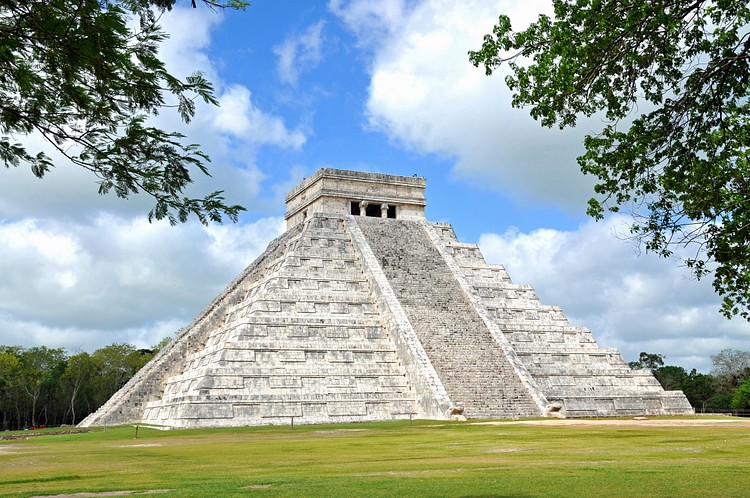
Chichen Itza, located at the northern tip of the Yucatán Peninsula of modern Mexico, was a Maya city which was later significantly influenced by the Toltec civilization. Flourishing between c. 750 and 1200 CE, the site is rich in monumental architecture and sculpture which promote themes of militarism and displays imagery of jaguars, eagles, and feathered-serpents. Probably a capital city ruling over a confederacy of neighbouring states, Chichen Itza was one of the great Mesoamerican cities and remains today one of the most popular tourist sites in Mexico.
HISTORICAL OVERVIEW
The name Chichen Itza probably derives from a large sinkhole known as the Sacred Cenote or 'mouth of the well of the Itza' into which the Maya threw offerings of jade and gold, and as the presence of bones testifies, human sacrifices. The early history of the site is still not clear, but settlement was certain by the Classic period (c. 250-900 CE). With the collapse of Teotihuacan, migrants may have come to the site from varying parts of Mesoamerica, and it seems likely there was contact with the Itza, a Maya group. A second period of construction seems to coincide with influence from the Toltec civilization.That Chichen Itza was a thriving trade centre with a port at Isla Cerritos is evidenced by finds of goods from elsewhere in Central America, for example, turquoise from the north, gold disks from the south, and obsidian from the Isthmus of Tehuantepec. The cultivation of cacao is known, and the city may have controlled the lucrative salt beds on the nearby northern coast.
DOMINATING CHICHEN ITZA IS THE HUGE PYRAMID OF KUKULCAN, ALSO KNOWN AS THE CASTILLO.
The city has been traditionally divided into two distinct parts and periods, even if there is some overlap both in time and design, and together they cover some 16 square kilometres. The earliest, in the south, is native Maya dating to the Epiclassic period (c. 800-1000 CE) with buildings displaying the distinct 'Puuc' architectural style and Maya hieroglyphs. The plan is more spread out than other parts of the city and, constructed on a roughly north-south axis, may reflect the course of the Xtoloc Cenote water source.
The second part of the city has been traditionally dated to 1000-1200 CE and is more mysterious, creating one of the most contentious debates in Mesoamerican archaeology. Built in the Florescent style and along a more ordered plan, it displays many hallmarks of the Toltec civilization, leading scholars to believe that they either conquered Chichen Itza as they expanded their empire from their capital Tula over 1,000 km away, or there was some sort of cultural and trade sharing between the two centres. Common features between the two cities found in architecture and relief sculpture include warrior columns, quetzal-feathered rattlesnakes, the clothing of subjects, chacmools (sacrificial basins in the form of a reclining person), atlantides (support columns in the form of standing males), the representation of certain animals, a tzompantli (sacrificial skull rack), Tlaloc (the rain god) incense burners, and personal names represented by glyphs which are present at both sites but which are not Maya.
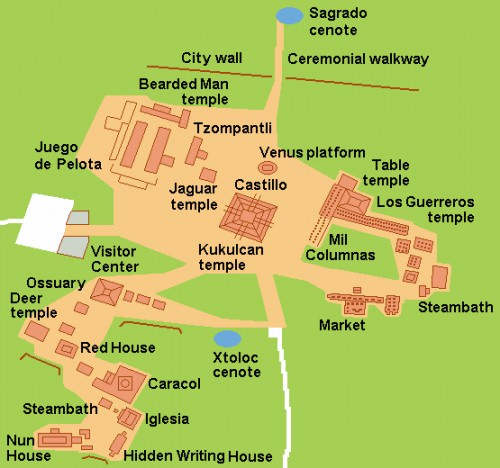
Map of Chichen Itza
Alternative to the two-period view, the Americas historian George Kubler divides the buildings of Chichen Itza into three distinct phases: prior to 800 CE, from 800 to 1050 CE, and 1050-1200 CE. Kubler adds that the latter stage saw the addition of ornate narrative reliefs to many of the buildings at the site. It has also been suggested that due to various styles of architecture pre-dating those found at the Toltec capital Tula, it may actually have been Chichen Itza which influenced the Toltec rather than the reverse. The exact relationship between the two cultures has yet to be ascertained for certain, and there are certainly other Mesoamerican (but non-Toltec) architectural and artistic features at Chichen Itza which are evidence of an influence from other sites such as Xochicalco and El Tajin.
Chichen Itza fell into a rapid decline from 1200 CE, and Mayapán became the new capital. However, unlike many other sites, Chichen Itza never disappeared from memory, and the city continued to be revered and esteemed as a place of ancestry and pilgrimage into the Postclassic period and up to the Spanish conquest, and even beyond.
ARCHITECTURAL HIGHLIGHTS
The earlier section of Chichen Itza displays many Classic Maya traits. The Temple of the Three Lintels, for example, has Chahk masks at each corner. Other structures include two small temples built on raised platforms, known as the Red House and the House of the Deer, and a pyramid known as the High Priest's Grave, named after the discovery of a tomb within it.There is also the 7th century CE Red House with its bloodletting frieze, the Nunnery with its carvings of the rain god Chac, and the small temple known as the Iglesia. All are Classic period structures.
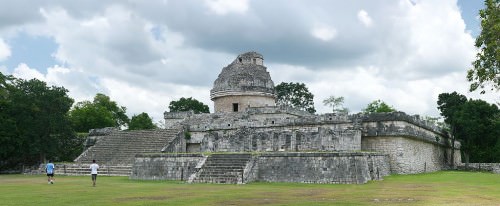
The Caracol, Chichen Itza
THE CARACOL
The Caracol is one of the most impressive monuments at the site. It was constructed prior to 800 CE and was used as an astronomical observatory, especially of Venus, and perhaps was also a temple to Kukulcan in his guise as the god of the winds. A large flight of stairs on two levels leads to the circular tower structure which has windows not aligned with the steps giving the illusion the tower is turning. The interior vaulting may have been designed to represent a conch shell (an object associated with Kukulcan), and a spiral staircase gives access to the second floor. The vault is over 10 m high, the largest such Maya structure. The building as it is seen today was probably a result of remodelling to incorporate Toltec design features.
PYRAMID OF KUKULCAN
Dominating Chichen Itza is the huge Pyramid of Kukulcan, also known as the Castillo (Castle), constructed before 1050 CE.The pyramid is 24 metres high, each side is 58-9 metres wide, and it has nine levels. On each side of the pyramid is a staircase which leads up to a single modest square structure. This summit building has two chambers and is decorated with jaguar relief panels and round shields. Each stairway climbing the pyramid has 91steps, except the northern side which has 92, and so, adding all four together, one arrives at a significant 365. Seen from above, the cross created by the stairways imposed on top of the square pyramid base recalls the Maya sign for zero. At certain times of year, for example on the autumnal equinox, triangular shadows from the different levels of the pyramid are cast onto the sides of the northern staircase, giving the illusion a gigantic snake is climbing the structure built in honour of the feathered-serpent god. The northern side also has large stone snake heads to further remind the purpose of the building. Used for religious ceremonies, human sacrifices would also have been made on the top terrace. Inside the pyramid another 9-level pyramid was built, this one with only a single staircase on the north side. Inside were a chacmool and a red jaguar throne inlaid with jade. This smaller pyramid was probably used for a royal burial, perhaps even of the great Toltec king Topiltzin Quetzalcoatl.
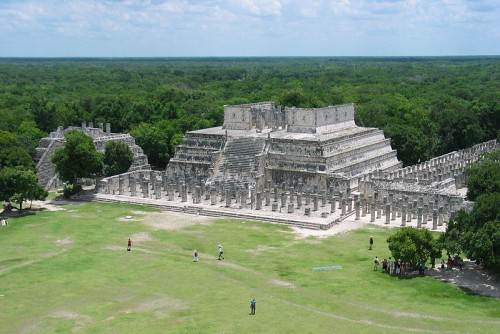
Temple of the Warriors, Chichen Itza
TEMPLE OF THE WARRIORS
Another huge structure at Chichen Itza is the Temple of the Warriors, a three-level pyramid with neighbouring colonnades on two sides creating a semi-enclosed court. It was built in the Early Post-Classic period, sometime between 800 and 1050 CE.The colonnade of carved warrior and female gift bearer columns in front of the pyramid would have once had a roof. The building at the top of the pyramid has a doorway framed with feathered-serpents and two chambers; one contained a chacmool and the other a throne. The structure shares many common features with the Toltec Pyramid B of Tula. Buried within the base of the temple is another, older structure known as the Temple of the Chacmool. The interior walls of the temple were decorated with wall paintings showing scenes of warriors with captives, a lake, and thatched houses, all with some attempt made at achieving perspective. Next to the Temple of the Warriors is a more ruined pyramid known as the Mercado which has a 36- column gallery in front of it, and a small ballcourt.
GREAT BALLCOURT
The Great Ballcourt of Chichen Itza, measuring 146 mx 36 m, is the largest in Mesoamerica. It was constructed between 1050 and 1200 CE and is also unusual in that the sides of the court are vertical and not sloped as in most other courts. Temple platforms close off each end of the court. The lower parts of the walls and the ring on each wall are decorated with carvings of snakes. The dimensions of the court are so grand that it is difficult to envisage actual games being played here. The rings, for example, through which players had to direct the solid rubber ball, are placed at a height of 8 m. The relief carvings on the walls of the court remind us of the ritual function of ball games; for example, there is a gruesome scene of two seven-man teams facing each other and one team captain decapitating the losing captain of the opposition. It is a scene repeated on all six relief panels along the two benches of the ballcourt.
TZOMPANTLI
Near the great ballcourt a large platform takes the form of a skull rack or tzompantli, and a second platform, the Platform of the Eagles, has relief carvings depicting jaguars and eagles eating human hearts. Both were built 1050-1200 CE, and they are further indicators that human sacrifice was a part of religious ceremonies at Chichen Itza.
MAP
See other Related Contents ››
LICENSE:
Article based on information obtained from these sources:with permission from the Website Ancient History Encyclopedia
Content is available under License Creative Commons: Attribution-NonCommercial-ShareAlike 3.0 Unported. CC-BY-NC-SA License